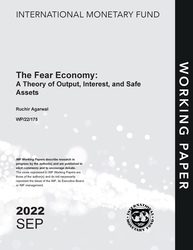
The Fear Economy: A Theory of Output, Interest, and Safe Assets
The Fear Economy: A Theory of Output, Interest, and Safe Assets
READ MORE...
Volume/Issue:
Volume 2022
Issue 175
Publication date: September 2022
ISBN: 9798400216084
$20.00
Add to Cart by clicking price of the language and format you'd like to purchase
Available Languages and Formats
| English |
Prices in red indicate formats that are not yet available but are forthcoming.
Topics covered in this book
This title contains information about the following subjects.
Click on a subject if you would like to see other titles with the same subjects.
Banks and Banking , Economics- Macroeconomics , Money and Monetary Policy , Economics / General , fear , business cycles , interest , safe assets , fear economy , government-administered interest rates , fear theory , business cycle model , fear factor , Output gap , Consumption , Zero lower bound , Interest rate floor , Yield curve , Global
Summary
This paper presents a fear theory of the economy, based on the interplay between fear of rare disasters and the interest rate on safe assets. To do this, I study the macroeconomic consequences of government-administered interest rates in the neoclassical real business cycle model. When the government has the power to fix the safe real interest rate, the gap between the `sticky real safe rate' and the `neutral rate' can generate far-reaching aggregate distortions. When fear exogenously rises, the demand for safe assets rise and the neutral rate falls. If the central bank does not lower the safe rate by the same amount, savings rise leading to a decline in consumption and aggregate demand. The same mechanism works in reverse, when fear falls. Quantitatively, I show that a single fear factor can simultaneously (i) generate cross-correlations in output, labor, consumption, and investment consistent with the postwar US economy; and (ii) generates variation in equity prices, bond prices, and a large risk premium in line with the asset pricing data. Six novel insights emerge from the model: (1) actively regulating the safe interest rate (in both directions) can mitigate the fluctuations generated by fear cycles; (2) recessions will be deeper and longer when central banks accept the zero lower bound and are unwilling to use negative rates; (3) a commitment to use negative rates in recessions—even if never implemented—raises both the short- and long-run real neutral rates, and moderates the business cycle; (4) counter-cyclical fiscal policy can act as disaster insurance and be expansionary by reducing fear; (5) quantitative easing can be narrowly effective only when fear is high at the lower bound; and (6) when fear is high, especially at the lower bound, policies that boost productivity also help fight recessions.
Copyright © 2010 - 2025
Powered by:
AIDC



